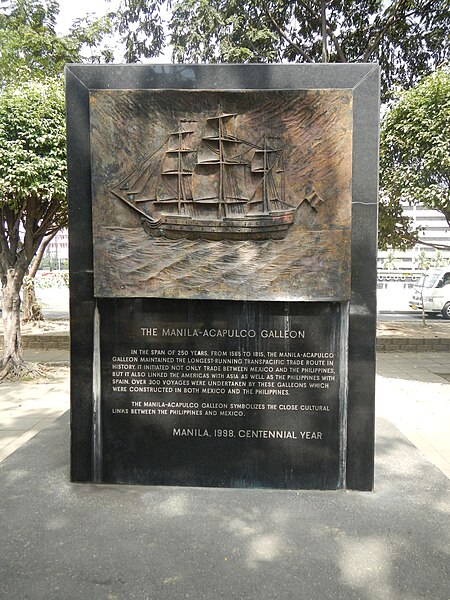I got a call from Ella Delaza of U-Travel a few weeks ago for an inquiry with a tour. Apparently she had already contracted a Mabuhay Guide before and was impressed with the quality of our guiding (ehem!) that she needed a guide to show a very important Mexican guest around Intramuros. However, this guest had a particular inclination to see the how deep the Mexican connection was in terms of our colonial life. I was impressed with Ella and U-Travel's desire to bend over backwards to enhance a guest's travel experience. He was, after all, visiting the Philippines for the first time.
I gladly obliged, as I had traveled extensively in Mexico in the 90's and have been convinced ever since that there's only one word to sum up the Manila-Mexico connection - DEEP! And so as the tour date was near, communications between Ella and myself had become more frequent. As it turned out, our guest was particularly interested in a monument. The Mexican Squadron 201! I told Ella that she shouldn't worry as there are so many inferences that point to our relations with Mexico over the centuries.
And so on the 4th of July, as we celebrated the Fil-American Friendship Day, Ella, Marco Aguilar (our guest) and myself were in Intramuros doing the tour. Marco is in the country for the first time as a guest speaker on the topic of success. He is a graphic designer by profession and has worked in marketing and advertising but found his calling as a motivational speaker. He is in Manila for a series of conferences after which he flies off to Cebu and Bohol to experience the country for himself.
 |
| there's a section on Philippine items in Cuernavaca and Acapulco |
Many Filipinos seem to have forgotten that despite the fact that we were a Spanish colony, the Philippines was administered from Mexico. So my visits to Mexico paid off as there are collections in Mexican museums in Acapulco Fuerza San Pedro) and Cuernavaca (Palacio de Cortes) of Philippine items brought over from the Galleon Trade. Our first stop was at San Agustin, of course, since they have dedicated the former Sala Recibidor as the Galleon room. All references on the almost three hundred years of trade from Acapulco to Manila are concentrated in that room. Marco was quite well informed of the galleon trade and was very receptive of the commentaries asking questions here and there as we toured the collections. We went around, the entire convento and finished shortly before lunch.
 |
| Mexican Squadron 201 Monument |
 |
| Aztec Eagles insignia |
Of the 300 recruits from Mexico, around 80 were fighter pilots. The rest were military personnel: staff, mechanics, health workers and support staff. They were mostly brought to Texas first were they started training on American planes. At least two pilots died while in training in Texas before they could even see action. The Mexican contingent were then moved to Louisiana and then brought to the Philippines in the US' Pacific campaign. Five of the pilots who actually flew on missions in the Far East died in the Philippines. Two of them crashed their planes, Two were shot down by Japanese firepower and one of them apparently got lost at sea when he ran out of fuel while while on a flight mission. Their names are inscribed in the monument.
The sad thing about the Mexican effort in WWII was that it was largely unnoticed by the public. They were given military honors upon their return to Mexico definitely. However, a lot of them have been forgotten by the younger generations. This monument of an eagle with a snake in its mouth is even obscured by a larger monument. No one would ever know it was there unless you were looking specifically for it.
In front of the smaller monument is the monument of Miguel Hidalgo. He is Mexico's counterpart of our national hero Jose Rizal. Hidalgo was the son of wealthy parents. He was well-educated and eventually answered his calling to become a Jesuit. Hidalgo, like Rizal, was aware of the abuses of the Spaniards and wrote essays and articles and also lobbied for reform in Mexico. For that reason, he is hailed as the Liberador de Mexico.
Even the pioneering efforts of Mexicans who were manning the galleons are not talked about... as if no one really remembers. So I brought Marco to Plaza Mexico with the marker of the Galleon trade and we talked about the parallelisms between Mexico and the Philippines under the yoke of Spanish colonialism.
 |
| Galleon Trade Marker in Plaza Mexico, Intramuros* |
Before we headed off to lunch, we went to Fort Santiago, passing through the Manila Cathedral. Where I showed him the revellin that has been converted into a chapel of Nstra, Sra. de Guadalupe. It was a sweet recollection for me as I recalled my visit to the shrine many years ago to pay homage to our Lady and to pray for my mother's well-being. My prayers were answered as she lived longer before she succumbed to heart failure in 2000.
On many levels this tour was a great success. My guest enjoyed seeing Manila from the Bayleaf Hotel's sundeck. After that, we headed off to Quiapo where I was supposed to show him the Black Nazarene and possibly a peek at the Muslim quarter as it was two days to Eid'l Fitr. But the rain started to pour and it was nearly half past four. so the guest had to get back to the hotel for another activity lined up for him. Many thanks to Ella Delaza and U-Travel for using my services for this tour. Aside from gaining a new friend, it brought back memories of my Mexican sojourn.









No comments:
Post a Comment